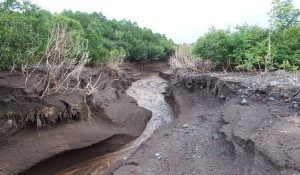The Bay of Bengal has long been known as a ‘STORM BREEDER’ according to the British Meteorologist, Henry Piddington, who coined the word ‘Cyclone‘ in 1840. This was not for the first time that the city of Kolkata has been hit by a twin disaster.
In October 1737 Calcutta was nearly obliterated followed by an earthquake, with an unimaginable scenario that had left the city in total rubbles. Thousands of dwellings were crushed to the ground, and they say that there was not a single building in the city that was left with four walls intact. Bridges were blown, wharves were carried off by surging water, godowns were emptied of their grains and even gunpowder from the magazines was scattered by the wind. People saw huge barges fluttering like kites in skies. This was the condition of Calcutta, the capital city of India from 1772 to 1912 during that devastating Cyclone. That’s why they say it never rains, it pours.
The Amphan disaster hit the Coastal areas of West Bengal and Odisha at a time when the entire world was fighting the Covid-19 pandemic. At the peak of the epidemic, India had to face the challenges of preparing for this super cyclone.
In the recent times the super Cyclone of Odisha in 1999 was the most devastating, killing more than 10,000 people on record. India thereafter has addressed this disaster with great deliberations and study. Cyclone Management can now be held as a success story in India and has the policies, framework, and resources very well-placed and poised to take on the fury of Nature.
The predictions by the IMD (India Meteorology Department) were accurate and the Cyclone followed the predicted path, thereby giving authorities an opportunity to plan evacuation, relief and response. The NCMC (National Crisis Management Committee) met on 16 May to take stock of the situation. The early warnings were given to locals, evacuation commenced, and the cyclone shelters were repurposed as Quarantine Centers in view of Corona Pandemic for the migrant labours coming in the states.
About 198 centers were utilised for this with almost 36,000 people housed in them. This forced the authorities to look for additional space to accommodate evacuees with social distancing norms to be followed, thereby reducing the capacity of these shelters from 1,000 to 400. The NDRF teams along with SDRF were deployed and the elements were thrown well ahead to evacuate people.
 This was the acid test of the disaster response mechanism, though Odisha has 20 years of rich experience in combating such situations. The takeaways were that we should have the capacity and resources to handle twin disasters simultaneously. The climate changes now dictate that extreme weather phenomenon have been occurring with increasing frequency over last two decades, concurrent calamities have to be factored in, and preparation will need empowering grassroots level administration, people, and framework.
This was the acid test of the disaster response mechanism, though Odisha has 20 years of rich experience in combating such situations. The takeaways were that we should have the capacity and resources to handle twin disasters simultaneously. The climate changes now dictate that extreme weather phenomenon have been occurring with increasing frequency over last two decades, concurrent calamities have to be factored in, and preparation will need empowering grassroots level administration, people, and framework.
Andhra Pradesh after Cyclone Hud Hud took drastic changes to reduce the impact of such severe calamities and since the impact of Amphan was more echeloned towards West Bengal and the landfall was in the Sunderban Delta in the Ganges, the role of mangroves need no emphasis. The submerged mangrove forests are scientific wonders, their complex aerial and submerged root system moderate current flows and the canopies moderate wind flows.
The city of Kolkata and the five districts of West Bengal have seen devastation and the challenges are complex in rural areas as the villages are inundated, their dwellings swept away. There was extensive damage to embankments that protect the interiors of islands, arable lands swamped by salt water. The wild life got perished and the lost boats and nets of fisherman will put a big question mark on livelihood.
The road map for state governments is to think of more plantations in coastal areas, protecting mangroves, and be more serious about climate change and adaptability. We can reduce the occurrence of such calamities by being most evolved species of Earth. However, humans have exploited them as captive resources assuming they exist only to serve them. The current crisis now offers us a huge opportunity to think of our behavior and to genuinely evolve. We must take this opportunity to learn to live far more sustainable lives.

Brig (Dr) Vinod Dutta
Brigadier Dr Vinod Dutta has almost three decades of experience in Disaster & Crisis Management, Response, Relief & Recovery, Supply Chain Logistics, and Training. Theformer Secretary, DCMG (Disaster Management), the Brigadier handled supply Chain Logistics during the KARGIL war, has been the Logistics Advisor to The Royal Govt of Bhutan and a faculty at prestigious colleges with a double masters in Management & Strategic Studies, a Law degree, M Phil in Management & PhD.

![Powerful Pride documentary Legendary Children [All Of Them Queer] streaming very soon](https://globalindianstories.org/wp-content/uploads/2025/06/Legendary-streaming-release-featured-238x178.jpg)



![Powerful Pride documentary Legendary Children [All Of Them Queer] streaming very soon](https://globalindianstories.org/wp-content/uploads/2025/06/Legendary-streaming-release-featured-100x75.jpg)

